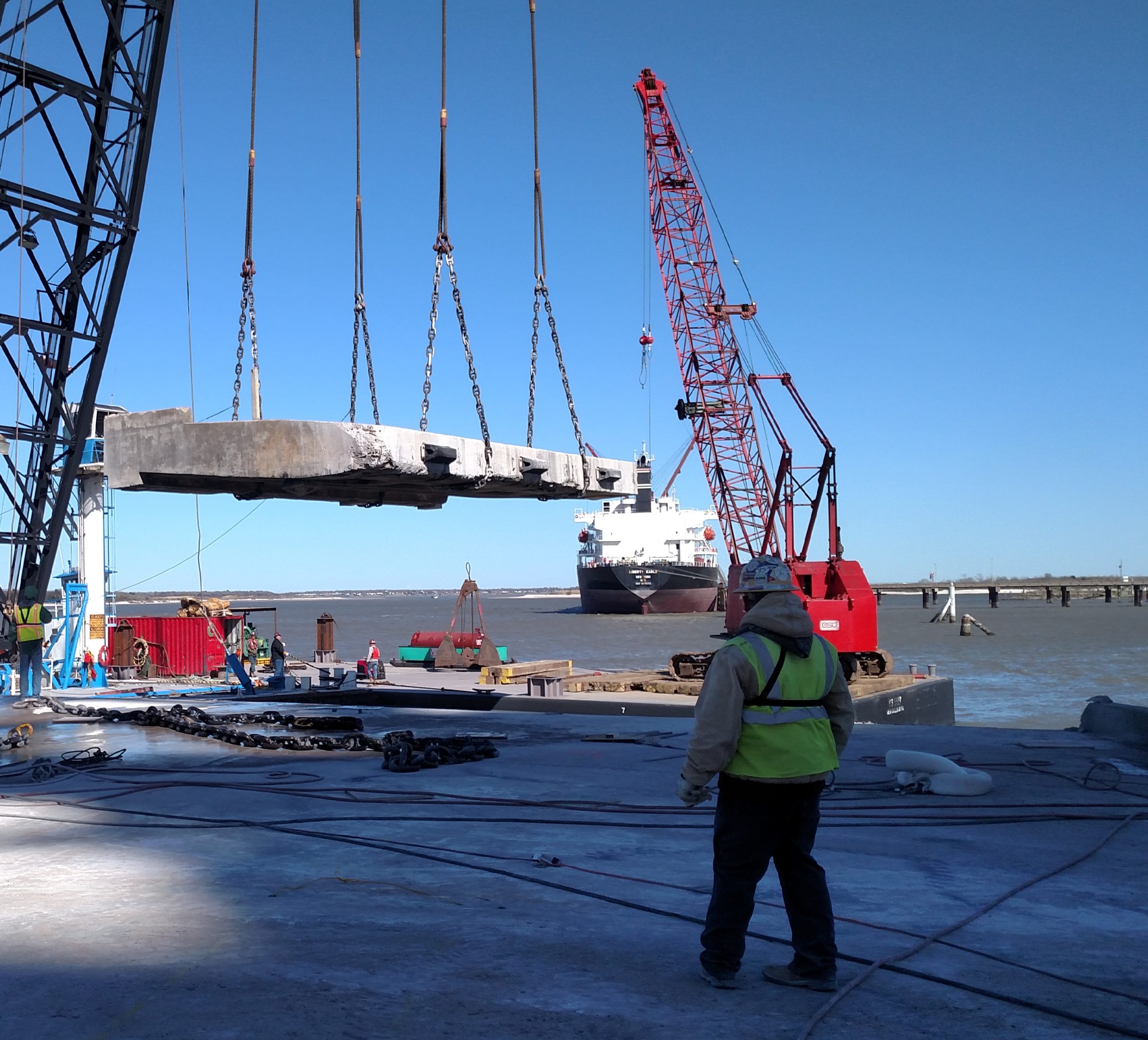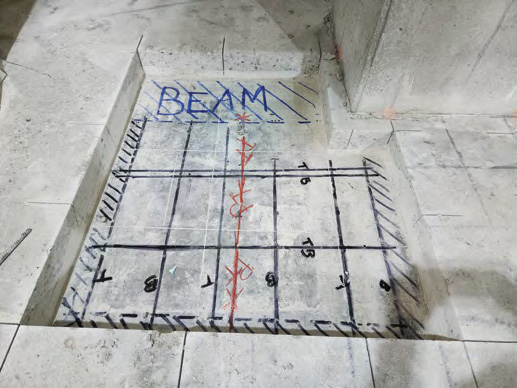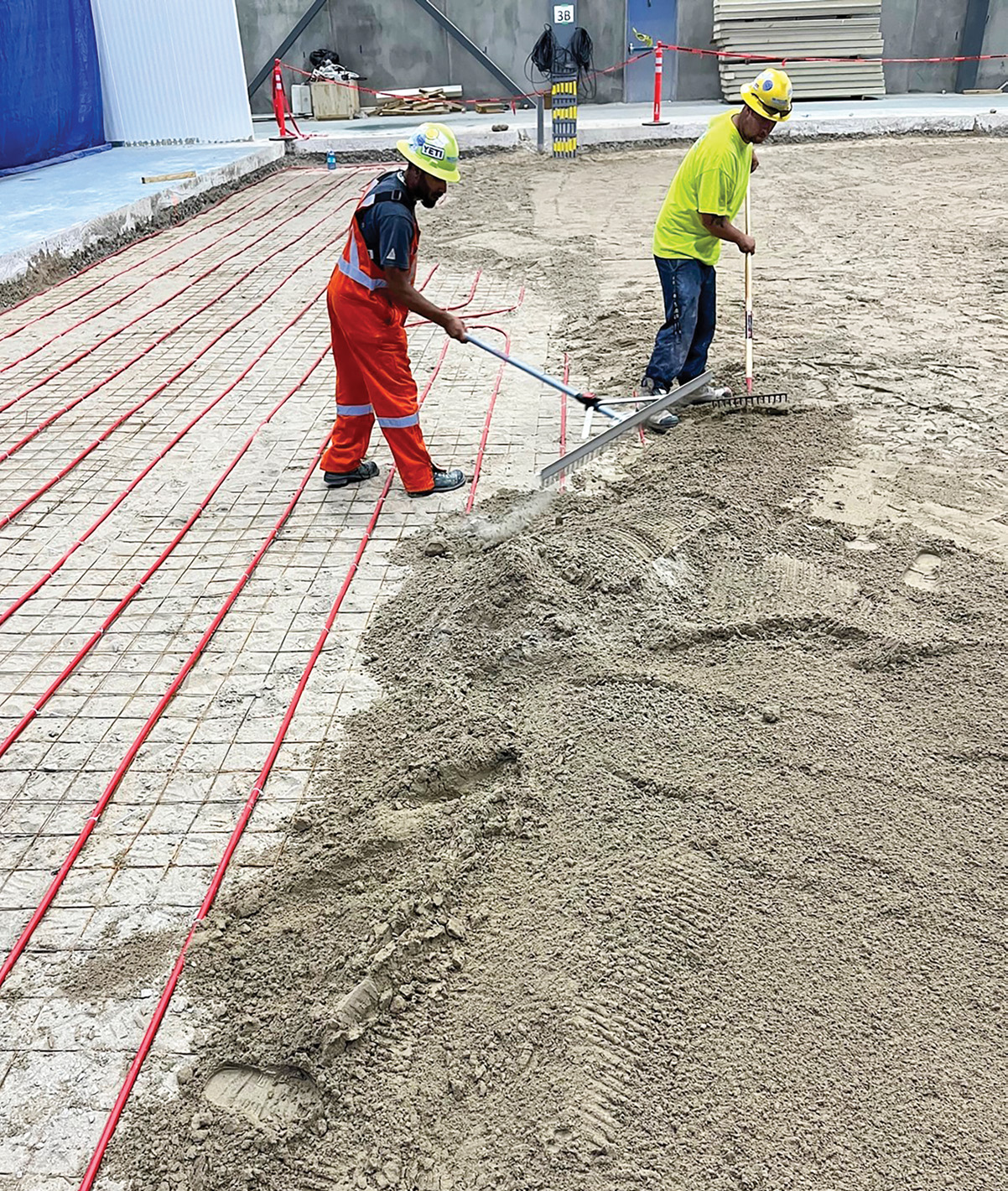
Expansive Cutting Work

Specialty Contractor Prepares Port of Houston for Historic Expansion
When a car breaks down on the side of the road, the driver calls a reputable towing company. When a company plans a conference, its representatives seek an experienced event coordinator. When a general contractor needs to remove 15,000 square feet of 16-inch-thick concrete weighing more than 3,000,000 pounds in one month, they contact a professional sawing and drilling contractor.
This is exactly why GSD Trading USA contacted CSDA member Holes Incorporated of Houston, Texas—to perform concrete cutting work on the Port of Houston Barbours Cut Container Terminal project. The port is undergoing major renovations to make room for larger ships as they make their way through Galveston Bay.
Expanding Houston’s Economy

A slab saw operator made cuts to separate the platform’s deck slab into sections.
The Port of Houston plays a major role in the development of the city, receiving more than 7,800 vessel calls every year. The Barbours Cut Container Terminal is the largest container terminal on the U.S. Gulf Coast and much of the container activity at the port takes place at this terminal.
Holes Incorporated was contracted to handle a vital aspect of the rehabilitation to Wharf 2, which was the removal of the roll-on/roll-off platform—a shore-based ramp that allowed wheeled cargo like cars, trucks and railcars to be efficiently rolled on and off vessels when in port. The restoration and overall port self-expansion is in preparation for the $5.5 billion Panama Canal expansion approved by the Panamanian government in 2006. The Panama Canal expansion will enable room for new Panamax ships, which can carry 13,000 standard shipping containers—or TEUs—rather than the 5,000 capacity of existing ships.
As part of an $85 million project for Bayport and Barbours Cut improvements, both terminals are being widened and deepened to enable ships with drafts up to 45 feet to utilize the port’s facilities.
The scope of the project handled by Holes Incorporated was to disassemble a concrete dock and ramp, measuring approximately 15,000 square feet, so that sections could be lifted off by crane. Each piece marked for removal and lifting weighed approximately 550,000 pounds. The deadline? One month.
Challenges and Limitations
In terms of completing high-profile jobs near or over water, this was not the contractor’s first rodeo. Previous work experience and an exemplary safety record provided the specialty sawing and drilling contractor with the tools to manage the challenges and limitations that were presented during a project of this stature.
“I believe we were selected for numerous reasons, one being our previous work experience and handling of projects over water, two our working relationship with craning company, Big John Machine Services, speaks volumes to the quality of our crews, three we were able to produce the results in the allotted time frame given and, fourth, most importantly, our safety record,” said Lee Aitken, Senior Estimator for Holes Incorporated.
The Port of Houston requested that the cutting contractor choose a method that would prevent any debris or concrete pieces from falling into the ship channel. Fallen concrete would have caused a delay on the entire rehabilitation and required the Port of Houston to hire divers to retrieve debris. Any remaining debris would have caused damage to ships traveling through. The method of choice to perform the work was concrete sawing, utilizing wire sawing, slab sawing and core drilling to complete the project.
Debris was not the only thing Holes Incorporated was trying to keep out of the water. One of the biggest challenges for this project was dealing with high tides and keeping the crew safe at all times. Due to the nature of the project, protective floatation devices had to be worn by the crew at all times while on or below the dock. The crew of 10 had to be extremely cautious during strong winds and the high waves caused by ship traffic. With limited height access underneath the dock, it was necessary for work to be scheduled during low tide times to keep everyone safe. Even at low tide, operators encountered low clearances and choppy water so maintaining awareness, tying down equipment and utilizing tool lanyards was of extreme importance.
Pre-cutting work involved using a Core Cut slab saw from Diamond Products fitted with a 42-inch-diameter diamond blade to make 10 cuts 16 inches deep and 47.5 inches wide to split the concrete platform into the planned 11 sections. Cardi and Shibuya core drill was employed to make a series of 12-inch-diameter holes in the 16-inch-thick slab for rigging access. It was then time to go under the platform for the wire saw cuts.

The cutting crew performed wire sawing tasks from a floating work barge.
Holes Incorporated employed three two-man crews that worked from floating barges under the platform to perform a series of 90 wire saw pull cuts. These cuts separated the deck slab from its 24-inch-square reinforced support piles below. The contractor left 28 piles uncut so the platform sections were not completely free until crane rigging was attached and final cuts made. All cuts were made flush to the underside of the deck slab, which not only provided a smooth surface for the crane operator to lower onto the barge but also gave the remaining pile sections a clear elevation out of the water for their removal.
While on the floating barge, a core drill operator mounted a rig to the vertical faces of some piles and created 6-inch-diameter holes for rigging. Once all deck slab sections were removed, the remaining pile sections were to be removed too.
Holes Incorporated completed the necessary pre-cutting tasks—with the grace of synchronized swimmers—after which the cutting crew and Big John Marine Services worked hand-in-hand to remove each of the 11 sections one by one. Beginning with the outer edge of the platform, each section was carefully rigged to the crane and a final set of beam cuts made to free it for removal. This totaled a further 28 wire saw pull cuts.

The slab sections each weighed 550,000 pounds.
The moment cutting was complete, the section was lifted and set on the waiting barge for disposal. Due to the size, weight and manner in which each section had to be removed, only four sections could be removed each day. It was evident the contractor and crane operator had devised the right methods and approach for the work, as the project was completed on time and within budget.
“The project went extremely well,” said Aitken. “Potentially, there were alternative methods, such as using hoe rams on excavators to break the concrete dock down, but we chose the method that felt most safe and met the needs of our client, and it paid off.”
The Impact to Come
There is no doubt the expansion of the Panama Canal is going to create tremendous opportunities for the city of Houston in the near future. A decade ago, all container volume from East Asia was arriving on the West Coast of the U.S. and transported into Texas by train. Now, the Port of Houston has two weekly services from Asia to Houston. Houston is ranked number 10 in total imports and exports, after Dallas-Fort Worth (No. 9) and Cleveland, Ohio (No. 8). This ranking could soon change as the completion of the Panama Canal’s expansion approaches.
“To be a part of an expansion of this magnitude is a big testament to the work we do here at Holes Incorporated To contribute to the overall growth of the city’s economy is a great feeling for us,” said Aitken. “When we look back after everything is complete, we can know with pride we contributed to that piece of Houston’s history.”
Company Profile
Holes Incorporated, based in Houston, Texas, has been in business since 1972 and a CSDA member company for 40 years. The company specializes in concrete wall sawing, slab sawing, core drilling, wire sawing, scanning, breaking, anchor bolt installation, demolition and load and haul. Holes Incorporated performs commercial, industrial, residential, state highway and municipality work. Holes is a CSDA Certified Company and employs CSDA Certified Operators.
Resources
General Contractor:
GSD Trading USA
Sawing and Drilling Contractor:
Holes Incorporated
Houston, Texas
Phone: 2814697070
Email: kellie@holesincorporated.com
Website: www.holesincorporated.com
Methods Used: Slab Sawing, Wire Sawing














